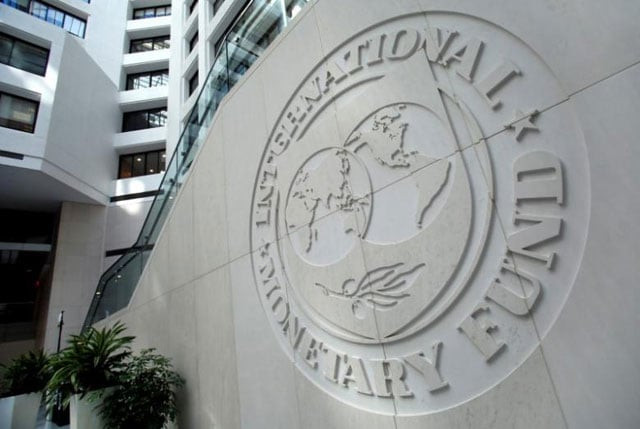Bond float not enough, Pakistan going to be IMF’s customer again
This time conditions will be harsher as country could not meet some tough terms previously

This time conditions will be harsher as country could not meet some tough terms previously. PHOTO: REUTERS
Government officials claimed at almost every economic forum that Pakistan was set to become the next Asian Tiger and that 2017 would be the launch pad for the national economy.
IMF says Pakistan can manage without its support
Things looked on track in early months of the year. The KSE-100 Index powered its way to an all-time high close to 53,000 points.
Given the celebrity status accorded to the PSX in mainstream media, everybody took this as a sign of still more good things to come. One mutual fund manager told me that by the end of 2017, the KSE-100 would hit 65,000.
As it turned out, progress on the economic front snapped in the second half of 2017. The KSE-100 Index receded so swiftly that it even caught industry pundits off guard. The index traded around 40,500 points on December 29, 2017 – the last trading day of the year.
The economic pain was not confined to the capital market alone. The external sector came under severe strain due to a worsening trade deficit and high public debt repayments. Pakistan’s foreign exchange market also endured mounting pressure on the rupee as the country’s foreign currency reserves decreased each month. All of these adverse developments have turned a rosy picture of the economy into a very bleak one for the new calendar year. Talk of the town is that Pakistan will apply for another IMF bailout in 2018 after general elections to avert another balance of payments’ crisis.
The government contends that the ouster of ex-prime minister Nawaz Sharif by the Supreme Court is the main reason behind the poor outlook on the economy since his economic policies were market-friendly and pro-growth.
Economic commentators, on the other hand, point out that despite his reputation as being pro-market, the economic policies of Nawaz and his financial czar Ishaq Dar were detrimental to the economy.
They add that positive outlook on the economy was an illusion at best and next year will be just like 2013 when the government had to go to the IMF for rescue of the economy.
However, fundamentals of the economy suggest that it is in a far better state than it was before the 2013 general elections.
2017: Positives of the economy
Pakistani economy is not really in that bad shape. Inflation rate has remained under control throughout the year as per official statistics.
Though there are some valid doubts about the veracity of inflation statistics, prices of major commodities have not accelerated at a quick pace. However, the CPI inflation rate was in double digits in 2013.
The ability of the government to raise funds from the international capital market by floating Sukuk and Eurobonds at relatively low interest rates shows that foreign investors are confident about the prospects of Pakistan’s economy. Pakistan had no presence in the international capital market in 2013.
The government has signed contracts for liquefied natural gas (LNG) imports with Qatar. LNG is going to improve the energy mix. In addition to this, the electricity produced by LNG is quite cheaper compared to that produced by furnace oil.
As per one estimate, around $1.5-2 billion will be saved due to LNG imports. Compressed natural gas (CNG) pumping stations have also resumed operations across the country which is more efficient for automobiles than petrol.
Similarly, the situation has also markedly improved as far as power outages are concerned when comparison is made with the last general elections.
The recent rupee depreciation, which was long overdue, is more like a technical correction and has nothing to do with adverse investor sentiments. We shouldn’t really be too sceptical about its effects on the economy.
2018: What lies ahead for Pakistan’s economy?
The most serious issue Pakistani economy is facing at the moment is that of external sector crisis. A 10% growth in exports during Jul-Nov FY18 has not prevented the trade deficit from worsening as imports do not show any signs of slowdown despite imposition of import tariffs.
As much as one hates it, IMF borrowing isn’t a bad deal
So it looks like Pakistan is going to become IMF’s customer again. The amount of money raised by the government by floating bonds in the international capital market is not enough to cover debt payments and the import bill.
Pakistani government has already started appeasing the IMF by depreciating the rupee and resuming its programme to privatise loss-making enterprises like Pakistan Steel Mills (PSM) and Pakistan International Airlines (PIA) along with power generation (Gencos) and supplying (DISCOs) companies.
However, this time we can expect harsher conditions from the IMF since we withdrew from some of the crucial policy commitments during the last IMF programme.
As far as the PSX is concerned, I expect it to improve after the caretaker government is appointed. Some of the market participants told me that once general elections are over, bulls will briefly take the reins. They believe that the PSX will give a return of at least 20% in 2018.
The writer is a researcher and works in the development sector of Gilgit
Published in The Express Tribune, January 1st, 2018.
Like Business on Facebook, follow @TribuneBiz on Twitter to stay informed and join in the conversation.



















COMMENTS
Comments are moderated and generally will be posted if they are on-topic and not abusive.
For more information, please see our Comments FAQ